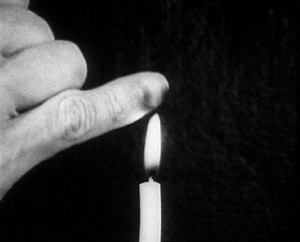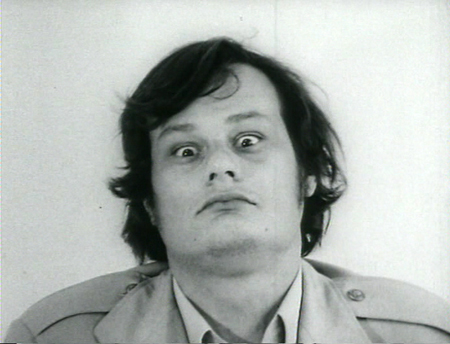What: Mike Parr artist talk
Where: Australian Centre for Contemporary Art (ACCA)
When: 8 September 2010, 6pm
I was so busy at work on Wednesday. Usually with that kind of work load I’d be there til 8pm. But no matter what, I could not miss seeing Mike Parr speak at ACCA. Seeing videos of his performance art from the 70s at the current Gestures and Procedures exhibition, where he’d hold his breath until he almost passed out or when he held his finger in a flame for as long as possible (almost unbearable to watch), intrigued me beyond anything.
MIKE PARR
Hold your finger in a candle flame for as long as possible (video still from 1972)
I managed to get to ACCA relatively early and bumped into our art teacher, Tony Garifalakis, who was having coffee and a ciggie at the Malthouse. We had a great chat about art, and he told me about Matthew Barney‘s studio party in New York of which replicas of the Chrysler building from his Cremaster series were present (crazy). Meanwhile, for the whole time, sitting behind us was Mike Parr himself!
I made my way into ACCA’s foyer and found a seat in an inconspicuous corner so I could take notes and not disturb the audience with my pencil scratching (as my lecturer Charles Green says, “No pens in art galleries. Only pencils!”) Soon enough, Mike came on stage and I started scrawling like a journalist on speed.
He began by talking about his interest in minimal art as a thought, rather than a thing or object, e.g. a painting. He made his final painting in 1970 after feeling compelled to turn his art into a gesture. An elemental, fundamental and minimal action.
As a result, he began to write a series of minimalistic tasks to carry out. These tasks were instructional, similar to Sol LeWitt’s wall drawings, but in single sentences and as actions. Here is (small) sample of these tasks:
- Swallow a lump of marble
- Sew a fish to your skin
- Insert a small fish up your nose
- Continuously drop a brick on your foot
- Hold your breath until you pass out
- Hold your finger in a candle flame for as long as possible
- Sew a word on your arm
- Let your friend bite your shoulder until blood appears
- Disturb the occupants of an ordinary suburban household
… and my personal favourite:
- Continue to lick the walls of an art gallery until your tongue bleeds and you leave blood on the wall
MIKE PARR
Push a fish up your nose
Photograph from 1975
Not being very familiar with his body of work, at this point I was completely fascinated. What did this all mean? What is the point of it all?
Fittingly, Mike explained that the real point of his art is its pointlessness. This is crucial in order for it to establish new meanings. Being so self-willed and completely pointless, his art does not illustrate anything, and it breaks up and destroys the sanctity of art itself. The result? A situation where you can invest completely new contexts to it. A myriad of interpretations that equally hold weight.
Interestingly, he admitted that when he first performed these tasks he wasn’t really sure why he was doing them. He was completely uncertain about the implications and consequences of his actions and how that might make the audience feel. But he felt completely certain about the action itself. He described the moment when he first performed “Let a friend bite on your shoulder until blood appears”. The moment fellow artist Peter Kennedy bit into his shoulder, he knew right then that he could not make a sound or show signs of pain for this would distress the audience greatly. He had to keep the audience at bay by the sheer force of intention in order to create a barrier between the act that was being carried out and the audience.
This was 1972. Such performance art rarely existed in Australia and there was no level of ‘comfort’ built into the social construct at the time for the viewing of such art. As it was the first live extreme performance in Australia, it put the audience in a quandary. Immediately after the performance, of which Peter chewed Mike’s shoulder for an entire two and a half minutes, art historian and critic Terry Smith tried to interpret and explain what had just happened to a completely confused, alienated and despairing audience. Despite Mike showing no signs of pain and completely in control, they felt guilty because they didn’t help free him of the torture, as they could have very easily done so.
Mike’s sheer force of intention to withstand pain and carry out his task amplified his presence in the room. Yet, at the same time, he alienated his audience, causing them discomfort, creating confusion and the feeling of helplessness. He realised at this point that he had found a way to communicate and free him from his own burden of confusion and feelings of despair, and from the helplessness and isolation that he had been suffering in his life. He found a way to impose the same feeling on to others without having to explain it in words, or pictures. I was completely blown away by this notion because that was exactly how I felt when I saw his video footage at Gestures and Procedures.
This was the main thing I took away from Mike’s talk. By creating inarticulate events the audience is able to, in their interpretation, utilise it in the various discourses of the social, political and the psychological. It also created a completely new experience, a fully human ability to create both presence and absence simultaneously.
MIKE PARR
Hold your breath for as long as possible (still from video, 1972)
The talk went for a lot longer than this and he covered far more about his practice. But transcribing the entire talk would make this post too long and so I’ve put all the interesting bits in bullet points!
- Mike discussed the re-enactment of a work from 1971 at the Campbelltown City Council this year where he immersed a clear perspex cube containing pure water into the polluted water of an urban river, photographed the cube in the river water and called it “a hole in nature”.
- I found this particular task quite interesting: Place a square block of concrete on a grass lawn until the grass underneath the block turns yellow. Remove the block and replenish the yellowed grass with cow manure and water mixture until it turns green again. The concept was to create a yellow square of grass in a lawn of green grass and make it invisible again. So simple yet so intriguing. I started to think about the yo-yo’ing behaviour of human beings with self-destructiveness and replenishment.
- Parr talked about his desire to present facts. This culminated in his piece Wall Definition (1971), a book containing 254 pages filled with definitions starting with the word “wall”. He would write down the definition of “wall”, and then each word in this definition would have its own definition, and so on and so forth. A definition of definition. Ad infinitum. He typed for two hours a day, for 40 days.
- His work arising from the Tampa children overboard incident was a reaction to the comment that throwing children overboard was “un-Australian”. He felt this was a ridiculous comment as Australian children are abused all the time. He wanted to show what being “un-Australian” really meant by exposing the desolate behaviour of asylum seekers held in our detention centres (that was usually kept from the public). It was performance art in a polemical sort of way.
- The necessity in art is to be free. To be inventive and productive in your own terms. He was incredibly disdainful of the processes and instruction of art school at the time where they made him draw from plaster casts.
- He believes that art does not work like language, but rather it is an inventive form.
- Experiencing contradictions is a necessity
- Art is the essence of humanity
- Desolation, deprivation and despair can create a religious state
- He once sat in front of an audience and branded his arm with the word “artist”. He asked if anyone else wanted to be branded an artist. No one took up on his offer.
Overall, I had a brilliant night. Mike Parr is such an insightful man. He was incredibly articulate about his practice and art in general. I could have kept on listening to what he had to say, even if it continued for much much longer than the 1.5 hours in which he spoke.
A big thank you to ACCA for organising this and for letting me tag along despite it being fully booked!



Damn… I wish I could have been there. Sounds so good.
Very intriguing!! It’s not exactly the type of thing that comes to my mind when I think “art”.
I don’t think I would have the stomach to watch these performances…
Surely, there should be a disclaimer in his “performances”: Don’t try this at home, folks.
Hey there! Thanks for your comment! Great art challenges the way we see, think and feel, and they can come in any form, be it painting, sculpture, photography, video, audio, performance, etc!
You’re right. I totally cringed and had to watch out of one eye when I saw his finger burning in the flame. I used the opportunity to read all the feelings that went through me as I experienced it. It was crazy. Imagine watching it live!
I read recently that he once hacked off his prosthetic arm (Mike only has one arm and wore a prosthetic arm for this performance) and the audience didn’t know it wasn’t real and there was fake blood everywhere, but it looked mighty convincing. I reckon I would have fainted! But even if you knew it was prosthetic, it’s still quite a disturbing thing to see!
Pingback: These Are Your Instructions « Not-Quite-Critics